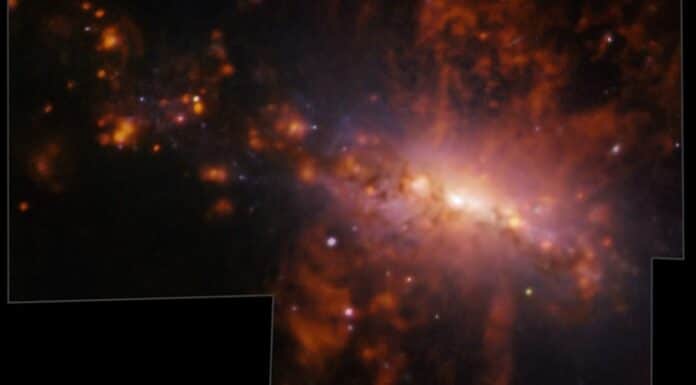Outflows powered by stellar feedback play a significant role in controlling the gas-star formation cycle. However, high-resolution observations that explain outflow physics are only possible in close galaxies, making ideal objects uncommon.
A new study from a team of international astronomers presents the first results from the new VLT/MUSE extensive program MAUVE (MUSE and ALMA Unveiling the Virgo Environment), which aims to understand the gas–star formation cycle within the context of the Virgo cluster environment. Astronomers studied the galaxy NGC 4383 in the nearby Virgo cluster. Their observations revealed a gas outflow so large that light would take 20,000 years to travel from one side to the other.
Massive amounts of hydrogen and heavier elements can be ejected by incredibly violent star explosions in the galaxy’s center regions, which is what causes this gas outflow. The amount of gas expelled is more than 50 million Suns’ worth.
In addition, astronomers have created the first high-resolution map of a massive explosion in the nearby galaxy NGC 4383. This map offers important clues on how the space between galaxies is polluted with chemical elements.
The team used data from the MAUVE survey to create this high-resolution map.
Lead author Dr Adam Watts, from the University of Western Australia node at the International Centre for Radio Astronomy Research (ICRAR), said very little is known about the physics of outflows and their properties because outflows are very hard to detect.
“The ejected gas is rich in heavy elements, giving us a unique view of the complex process of mixing hydrogen and metals in the outflowing gas. In this case, we can detect oxygen, nitrogen, sulfur, and other chemical elements”.
ICRAR researchers Professors Barbara Catinella and Luca Cortese, co-authors of the study and co-leaders of MAUVE, said, “We designed MAUVE to investigate how physical processes such as gas outflows help stop star formation in galaxies.”
“NGC 4383 was our first target, as we suspected something exciting was happening, but the data exceeded all our expectations.”
MAUVE observations in the future should provide a highly detailed picture of the significance of gas outflows in the nearby Universe.
Journal Reference:
- Adam B Watts, Luca Cortese, Barbara Catinella, Amelia Fraser-McKelvie, Eric Emsellem, Lodovico Coccato et al. MAUVE: a six kpc bipolar outflow launched from NGC 4383, one of the most H I-rich galaxies in the Virgo cluster. Monthly Notices of the Royal Astronomical Society. DOI: 10.1093/mnras/stae898
